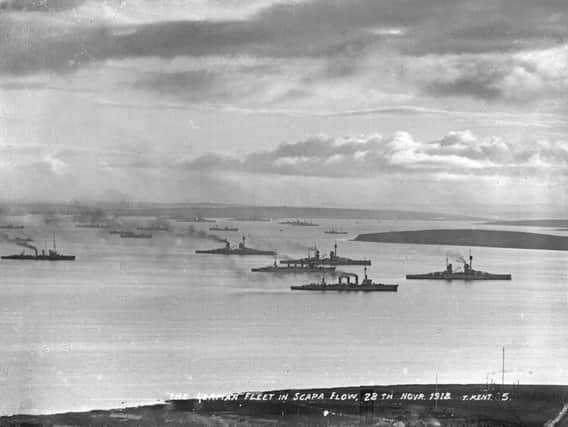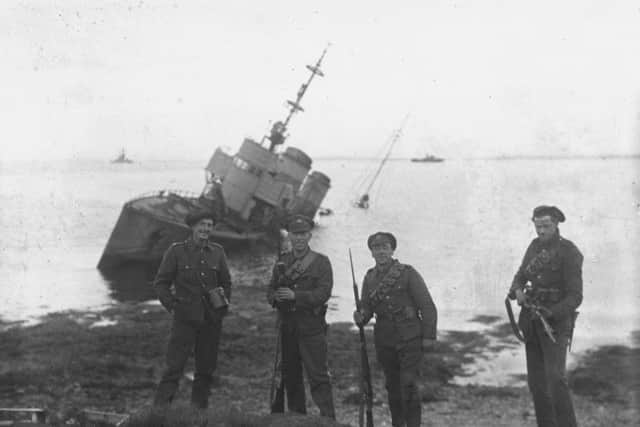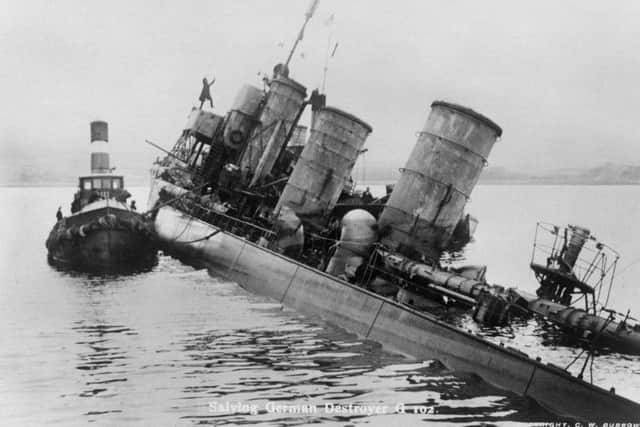Scapa Flow: The day the German navy scuttled their warships off Orkney


It will sound to mark the centenary of the destruction of the German High Seas Fleet, which was interned off Orkney, rusting and rotting and with at first 20,000 sailors on board, for seven months following the Armistice.
Today, a flotilla will gather for a service at Scapa Flow to mark the 100th anniversary of the scuttling, an extraordinary act which was executed as world leaders entered the final, weary stages of peace talks at Versailles where the future of the German fleet had proved to be a major sticking point.
Advertisement
Hide AdAdvertisement
Hide AdThat diplomatic hurdle was eased in bold style when Admiral Hans Hermann Ludwig von Reuter, in a final show of patriotism or perhaps honour for his undefeated ships of war, ordered the scuttling to stop any chance of them being seized by the Allies and shared out among the victors.


At around 10:30am on 21 June 1919, Reuter’s signal was given and, as the boats started to take on the water, the calm of the Flow was transformed.
The 74 vessels in the fleet had been secretly prepared to ensure the quickest demise possible with seals broken and holes drilled. Portholes were opened and the sound of sizzling and hissing filled the air as the cold sea touched hot steam pipes.
Whistles and high-pitched howls were released over the Flow as pipes ruptured. Bulkheads let out deep groans as the ships rolled. Sailors leapt from the ships into escape vessels.


Remarkably, a group of Orkney schoolchildren, out in a boat on a school trip, witnessed the extraordinary death of the enemy navy’s hardware that day.
As the once-mighty ships listed, their bells tolled for the last time as they disappeared below the surface.
The bell that will ring today was recovered from the sunken German battlecruiser SMS von der Tann, once the fastest of its kind on the sea.
Almost 100 years to the hour, the bell will ring seven times – each strike representing a German wreck that still lies on the seabed off Orkney – by the grandson of Reuter.
Advertisement
Hide AdAdvertisement
Hide AdFor author and naval historian Nick Jellicoe, the great grandson of World War One naval commander Admiral John Jellicoe, the bell ringing will be an “emotional” moment that will recall a “forgotten” part of the First World War.
Jellicoe, author of newly published The Last Days of the High Seas Fleet, said: “We are in danger of losing our history and what is so special about Scapa Flow and the scuttling is that it is part of a forgotten piece of that history.
“The fact is the last German casualties of the war died at Scapa Flow. What an end to this chapter of history.
“The German fleet took 20 years or so to build. In just two-and-a-half hours, around 420,000 tonnes of that military hardware goes to the bottom of the sea.”
It was estimated at the time that the German High Seas Fleet was worth £60 million. Today, the figure would be 50 times that.
Around 20,000 German sailors arrived with the High Seas Fleet at Scapa Flow following the November 1918 Armistice although the numbers fell away as repatriation of troops commenced. Sailors had food and water to last for 36 days. They hadn’t expected to be there longer than that.
While the Germans still felt a pride in their fleet, contemporary accounts described it as ‘dirty, disarmed, dishonoured and defeated’ and the source of many a disgusting smell. Filth was everywhere.
The “Scapa tap” was the name given to any sailor suffering the effects of the desolation, with depression common and hunger rife among the sailors, who were forbidden from leaving their ships.
Advertisement
Hide AdAdvertisement
Hide AdTheir diet was supplemented by fishing from the bulwarks, their catches fried up in torpedo oil. Seagulls were sometimes killed using flare pistols and on occasion, night raids on tiny islands were executed in order to steal a few sheep to slaughter.
It was hardly surprising that the British saw the Germans internment in Scapa as some sort of payback, Jellicoe said.
A Dutch naval historian Van der Vat wrote: “To the British officer, the fact that the Germans are being forced to live at Scapa Flow in their own ships is
one of the most perfect examples of poetic justice in the whole war.”
But within that poetry lies several uncomfortable truths.
Today, the floating service will move to Lyness Royal Naval Cemetery on the Island of Hoy. Among the graves are those of nine German sailors who died
in direct action at Scapa Flow, with the true circumstances surrounding some of the deaths only recently emerging.
The gravestone of 19-year-old German sailor Kuno Eversberg has recently been changed after new information was unearthed by Orkney-based diver Kevin Heath.
Eversberg’s gravestone said he had died on 21 June but Heath found he actually died on 29 June with the missing days now accounted for.
Advertisement
Hide AdAdvertisement
Hide AdAfter the scuttling, Eversberg was held prisoner on British battleship HMS Resolution and was shot in the back as he was escorted by two sentries, possibly as he went to the toilet.
James Woolley, 20, stood trial for the killing in Edinburgh but walked free after a not proven verdict was delivered.
A War Office memo discovered by Heath said there was evidence Woolley, who was likely drunk on rum at the time, wanted to kill a German given he had lost relatives in the war. Eversberg was shot and hospitalised in the early hours of 24 June and later died of sepsis.
Mr Jellicoe said: “Thank goodness the history has finally been corrected 100 years later. It is not the most glorious moment for the Royal Navy.
“What made it so sad is that his tombstone was marked with 21 June. It covered what had happened. If it had the proper date of his death, it should have begged the question ‘why the 29th?’ That wrong has now been put right.”
Another gravestone at Lyness marks the death of Walter Schumann – a senior German officer who refused to order his men back onto the ships to stop the scuttling. He was shot in the face, just above his top lip, by a young British officer, Lieutanant JPFG Turner, with his body unceremoniously dumped into a guard boat.
“After the scuttling, it went wild. I think it was a time of chaos and in the chaos, things got out of hand,” Jellicoe said.
Today, a number of wreaths will be thrown into the water at the wreck site with one to be taken down to the seabed by divers from both the British and German Navy. It is thought to be one of the first shared acts of commemoration made by both nations.
Advertisement
Hide AdAdvertisement
Hide AdA vast programme of events to mark ‘Scapa 100’ has been organised by diver Emily Turton, an expert on the Scapa Flow wrecks and one of a number of skippers who take dives out to the German wreck site, which is considered one of the best marine archaeological sites in the world and attracts thousands of divers every year.
The scuttling – and the salvage of the fleet – has proved lucrative for Orkney over time.
During the 1920s and 1930s the majority of the scuttled ships of the German High Seas Fleet were raised in the largest maritime salvage operation in history. Of the 52 ships that sank, only seven remain beneath the waters of Scapa Flow.
Ernest Cox, a brilliant London-based engineer, raised 32 ships for the valuable steel in the hulls. He had never raised a ship before. In his own words, experts thought him ‘crazy’ but to Cox the sunken German boats represented nothing more than a trove of scrap metal and he was determined to recover it at all costs.
His efforts created employment on Orkney for years.
“The fact is, if it had not been for all this steel at the bottom of Scapa, Orkney would have had a really tough time during the Depression. The salvage work created a massive industry and then there is tourism and maritime archaeology from the wrecks that are still on the sea bed,” Jellicoe said.
Lieutenant Jennifer Smith, Deptuy Naval Liaison Officer for Scotland, said the scuttling has had a profound effect on Orkney.
“It is still to date the greatest scuttle in history. There has never been, and probably never will be, something like this again.
“The feat of salvaging these battleships is one of the greatest legacies of the scuttling. It wasn’t just contained to 21 June 1919. It changed the history of Orkney.”
The Last Days of the High Seas Fleet by Nicholas Jellicoe is available now from Pen and Sword Books (www.pen-and-sword.co.uk), priced £20.